COP26 presented the rail industry with the opportunity to showcase its net-zero carbon traction. Vivarail and Hydroflex trains performed short demonstration trips from Glasgow Central, while at Bo’ness, 30 miles to the east, Scotland’s hydrogen train was on display. Although Alstom had no trains, at COP26 the company announced a significant development.
While these are future developments, on numerous imaginative station posters Scotland’s Railway proclaimed what it was already doing to save carbon. For example, its electrification programme is saving 5,000 elephants (30,000 tonnes) worth of carbon per year. These posters also promoted the class 385 electric train which carried many COP26 delegates from Edinburgh to Glasgow, as a “Net Zero Hero”.
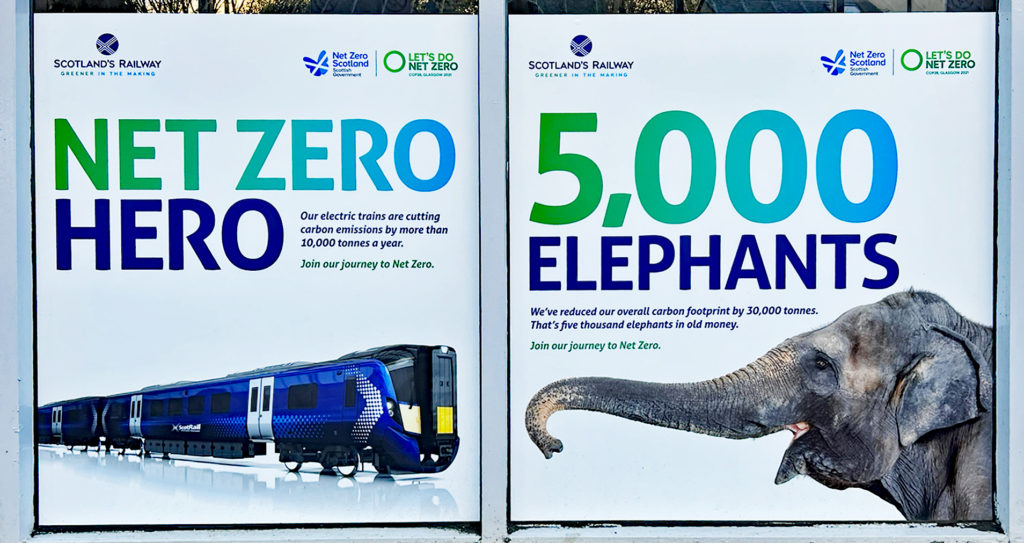
Vivarail
Departing from Glasgow Central station on a London Underground train is not an everyday occurrence. Yet this was the experience Vivarail offered to invited guests taking a trip on their innovative class 230 battery train during COP26. As reported in issue 186 (Sept/Oct 2020), the class 230 is a converted London Underground D78 unit. However, with its plush interior, the train’s origin would not have been obvious to an uninformed guest.
The three-car unit concerned, 230 001, was the prototype diesel unit for the three units that are now in service between Bedford and Bletchley. On board, Vivarail’s founder, Adrian Shooter, advised that the unit had been re-engineered as a battery-only train, with each coach having two 70kWh battery packs that could be recharged in 10 minutes using the company’s patented fast charge system, and that this offered a range of at least 80 miles.

While in Scotland the train had its longest battery-powered promotional run over the Forth Bridge. This required a 47-mile trip from Polmadie depot to Inverkeithing yard where the unit was charged overnight before returning to Polmadie. The demonstration trip was a 15-mile round trip to Barrhead from Glasgow Central.
Vivarail’s Head of Marketing, Alice Gilman, advised that the train had attracted much international interest. On my trip were representatives from Japan, El Salvador, Guatemala, and Mexico where Vivarail trains are being considered for use on the new Mayan line. Also on the train was Henry Posner whose Railroad Development Corporation (RDC) ordered a two-car, class 230 unit which is now running trips to demonstrate RDC’s pop-up metro concept in Pittsburgh, USA. RDC has ordered a second train which will be shipped to North America soon.
HydroFLEX
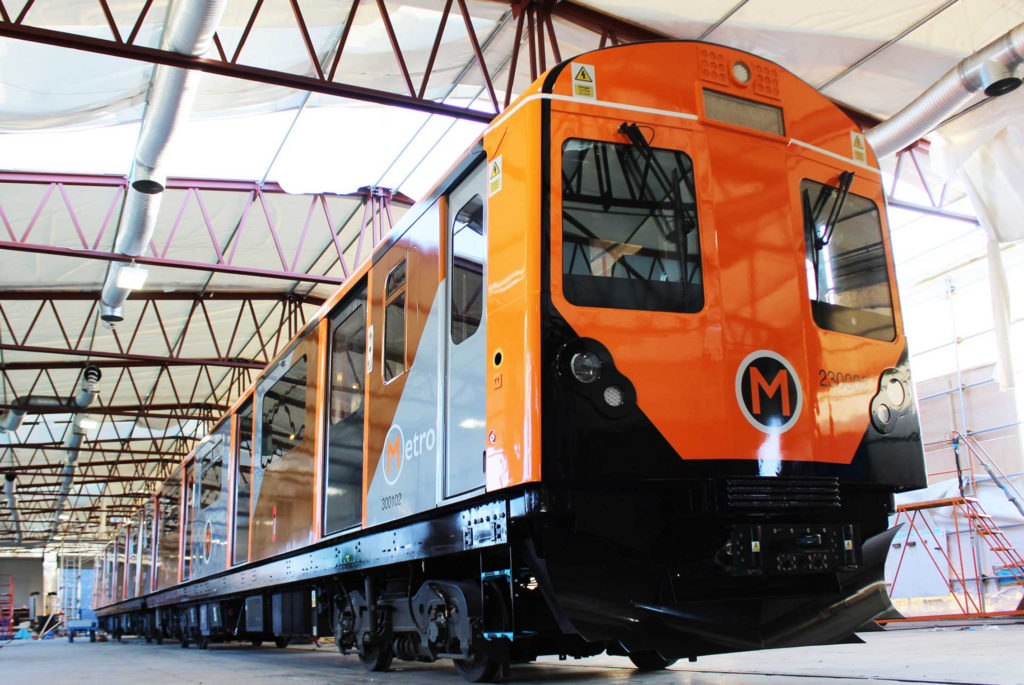
HyroFLEX is a collaboration between Porterbrook and the University of Birmingham’s Centre for Railway Research and Education (BCRRE) to convert a surplus four-car, class 319 EMU into a hydrogen train. The 319s were introduced in 1987 for the Thameslink route and so are capable of operation using 25kV AC overhead and 750V DC third rail. The units have a DC bus line which can be powered by a hydrogen traction package. This enables HydroFLEX to be a tri-mode unit powered by hydrogen, AC or DC.
The original HydroFLEX unit, 799 001, was a demonstrator unit with a 100kW fuel cell and a maximum speed of 50mph. It was demonstrated at Rail Live in 2019 and was the first hydrogen train to run on the main line in September 2020.
Following this successful main line test, another class 319 was converted into an upgraded HydroFLEX unit to give it the range and performance to operate a passenger service. It was also renumbered 799 201. This work was done at the Gemini Rail Services’ facility at Wolverton. This was the unit demonstrated at COP26. Porterbrook’s Innovation and Projects Director, Helen Simpson, explained that it is essentially a production version of HydroFLEX, although minor modifications may be required following mileage accumulation test runs.

The train has 36 Luxfer gas cylinders that each store a total of 277kg of hydrogen at 350 bar. The four fuel cells supplied by tpgroup deliver 700kW, and the 400kW traction battery is below the coach. Due to hydrogen’s low energy density the tanks, fuel cells, and control equipment occupy a full coach, hence only three of the unit’s four coaches are available for passengers. One of these coaches had an on-board boardroom to support discussions during COP26.
For five days during COP26, HydroFLEX made three demonstration runs per day from Glasgow Central over the six-mile Cathcart circle and the train was powered from the overhead line. Helen Simpson explained that the reason there was no hydrogen on board was to allow guests access inside the hydrogen coach.
Hydrogen at Bo’ness
As reported in issue 188 (Jan/Feb 2021), Arcola energy have been engaged to convert a surplus class 314 EMU into a hydrogen train to support the development of Scotland’s hydrogen economy.
The Scottish hydrogen train is being produced from a surplus class 314 unit that arrived at the workshops of the heritage Bo’ness and Kinneil railway just before Christmas last year. At the time it was envisaged that the train would be operational on the heritage railway during COP26. However, due to Covid and supply chain issues it was only possible to display a part-built hydrogen train at Bo’ness.



Although there was no opportunity to travel on a train, the exhibition that Arcola provided at Bo’ness was a particularly interesting event. Instead of components being on the train, they were laid out in a marquee with clear explanations of how they will work. This included the small permanent magnet AC motor that is to replace the original much larger DC motor. Using this AC motor, which is part of Arcola’s A-Drive hydrogen fuel cell power train, simplifies system integration of the new hydrogen traction equipment.
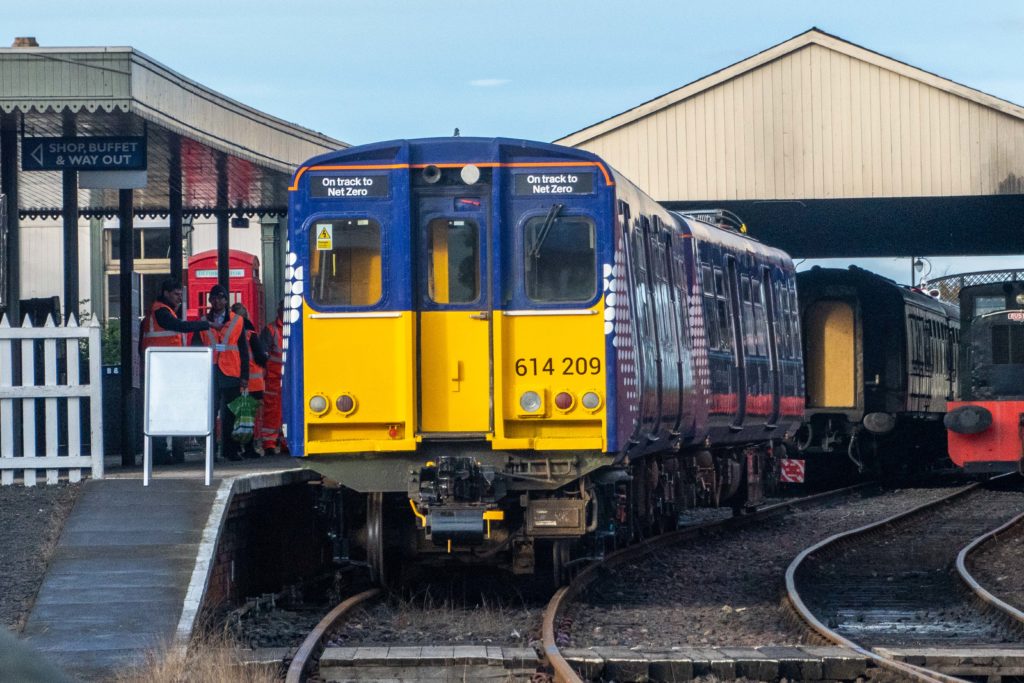
Arcola’s power train uses two 70kW Ballard fuel cells hybridised with high power batteries to provide over 350kW peak power. The underframe fuel cell raft incorporates high and low voltage power distribution, voltage and traction inverters, as well as air filtration and thermal management which could use waste heat from fuel cells to heat passenger compartments. Another underframe raft contains six hydrogen cylinders which store 80kg of hydrogen at 350 bar.
On display outside the marquee was the train, a hydrogen electrolyser, a 550 bar depot hydrogen storage tanks, a hydrogen bin lorry powered by Arcola’s power train, a demonstrator hydrogen bus project, and hydrogen powered lighting tower provided by TCP ECO, which offers a hundred hours of silent, pollution free, on-site lighting.
The exhibition at Bo’ness was therefore showcasing, not just the converted class 314, but other aspects of the nascent hydrogen economy of which such trains must eventually be part. Scotland’s hydrogen train is expected to be ready for demonstration runs on the Bo’ness and Kinneil railway next spring.
Thereafter, the intention is to trial the converted train on the mainline in 2023, use it for passenger trials in 2024, and work towards fleet operation of passenger services in 2025. HITANS (Highlands and Islands Transport Partnership) are keen to see hydrogen trains operating on the Far North line and have commissioned a study to determine the best configuration of hydrogen infrastructure onboard trains.
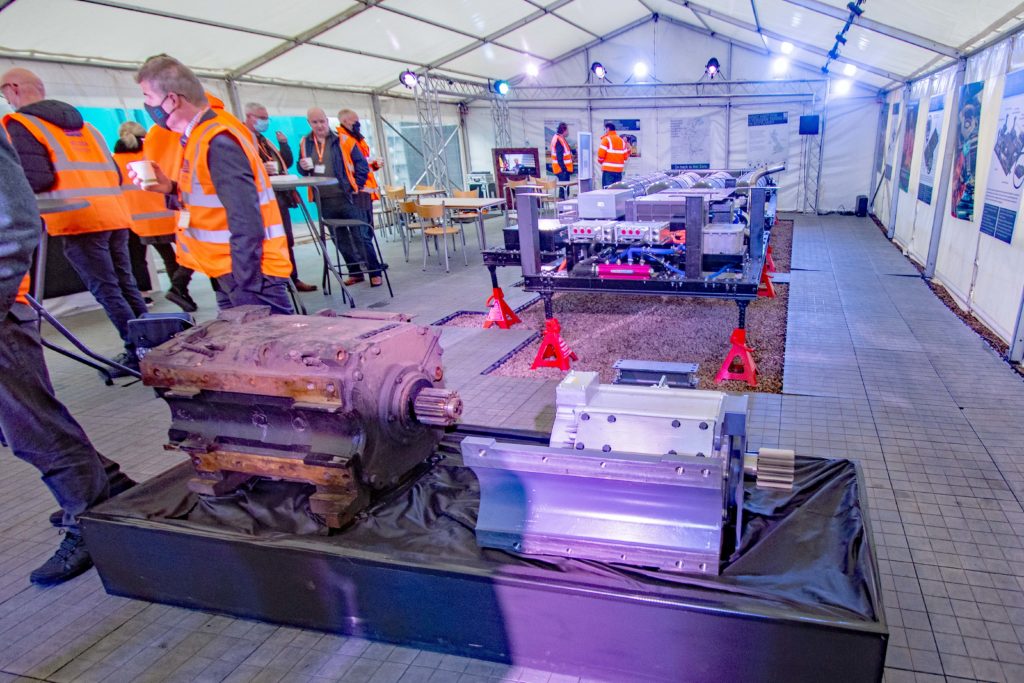
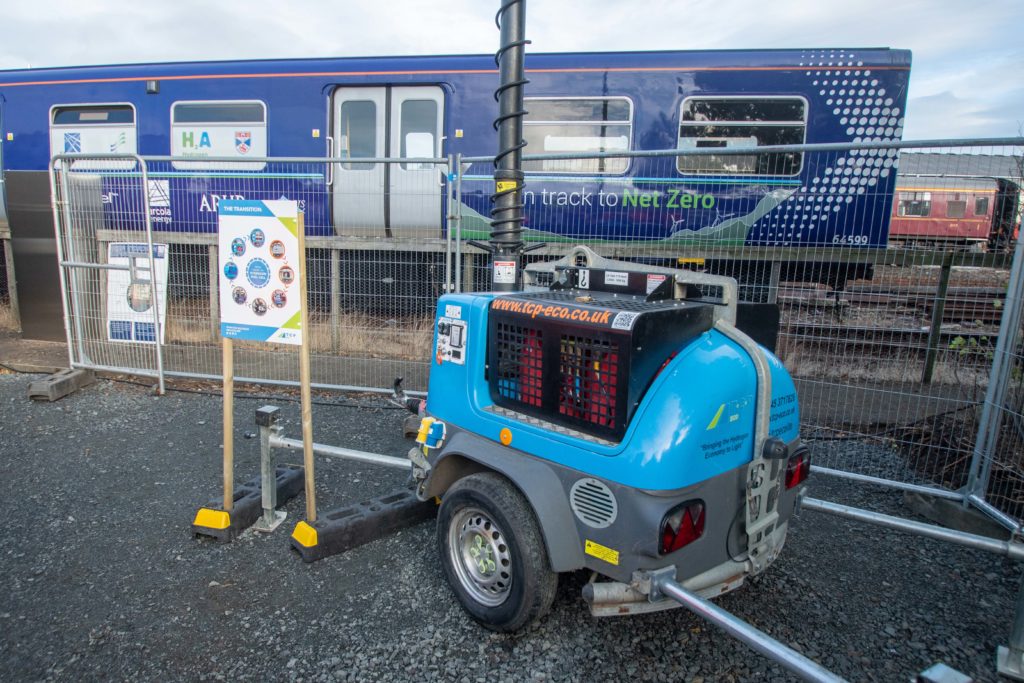

Alstom’s new hydrogen train
Alstom’s Coradia iLint is the world’s first hydrogen train and entered service in Germany in 2018. This fleet has run over 200,000km since then. The company has orders for two fleets of hydrogen trains in Germany totalling 41 trains, and has further hydrogen train orders from Italy and France.
Although the company did not have a train on display during COP26, it did give a presentation to the conference on 10 November which signalled a significant development. This was given by James O’Sullivan, Project Manager Aventra UK and Mike Muldoon, Head of Business Development, Transport UK and Ireland, and included the announcement that Alstom has just announced an agreement with Eversholt to design, build, commission and support a fleet of 10, three-car, brand-new hydrogen multiple units (HMUs) which will be an evolution of the company’s Aventra platform.
Both companies had previously worked together on the ‘Breeze’ project which was announced in 2019. Like HydroFLEX, this was to be a conversion of surplus electric multiple units. However, both companies now believe that there is a market for a fleet of new trains.

During the presentation, James O’Sullivan mentioned that these new trains would store hydrogen as effectively as possible with roof-mounted tanks to avoid encroaching passenger space as shown on the graphic of the new HMU in the press release. Neither HydroFLEX, nor the ‘Breeze’ concept were able to accommodate roof tanks within the UK loading gauge due to the constraints of modifying existing trains. However, the design of a new train provides more flexibility.
If Alstom are able produce a HMU without hydrogen encroaching passenger space they will clearly have a competitive product, which is likely to justify their speculative build of HMUs for which there is as yet no specified demand.
The main solution
The green trains showcased at Glasgow Central attracted much press attention, especially when they were visited by Prince Charles and the Prime Minister. Headlines considered these to be the trains of the future with no other aspects of rail decarbonisation attracting press interest.
Yet at Glasgow Central, Vivarail and HydroFLEX were surrounded by more efficient electric trains with greener credentials. The electric Pendolino that carried the Prime Minister to Glasgow at 125 mph was powered by electricity as it is generated. Batteries and hydrogen cannot offer such high-speed passenger services, or indeed freight trains.

On its demonstration run to Barrhead, the Vivarail train passed underneath the newly erected OLE structures which are part of Scotland’s rolling programme of electrification. In reality this offers more carbon savings than such alternative traction. Why Scotland has such a programme and England does not would have made an interesting story.
There is of course an essential role for battery and hydrogen trains, especially in the transition to a net zero railway. Those developing them are also to be commended for their work on this innovative traction. However, it is essential that these trains are seen in context. Network Rail’s Traction Decarbonisation Network Strategy considered that the required net zero traction mix for the unelectrified network should be 86% electrification, 9% hydrogen, and 5% batteries. Showcasing new green trains at COP26 does not change the fact that a large-scale electrification programme is needed if the rail network is to be decarbonised.



